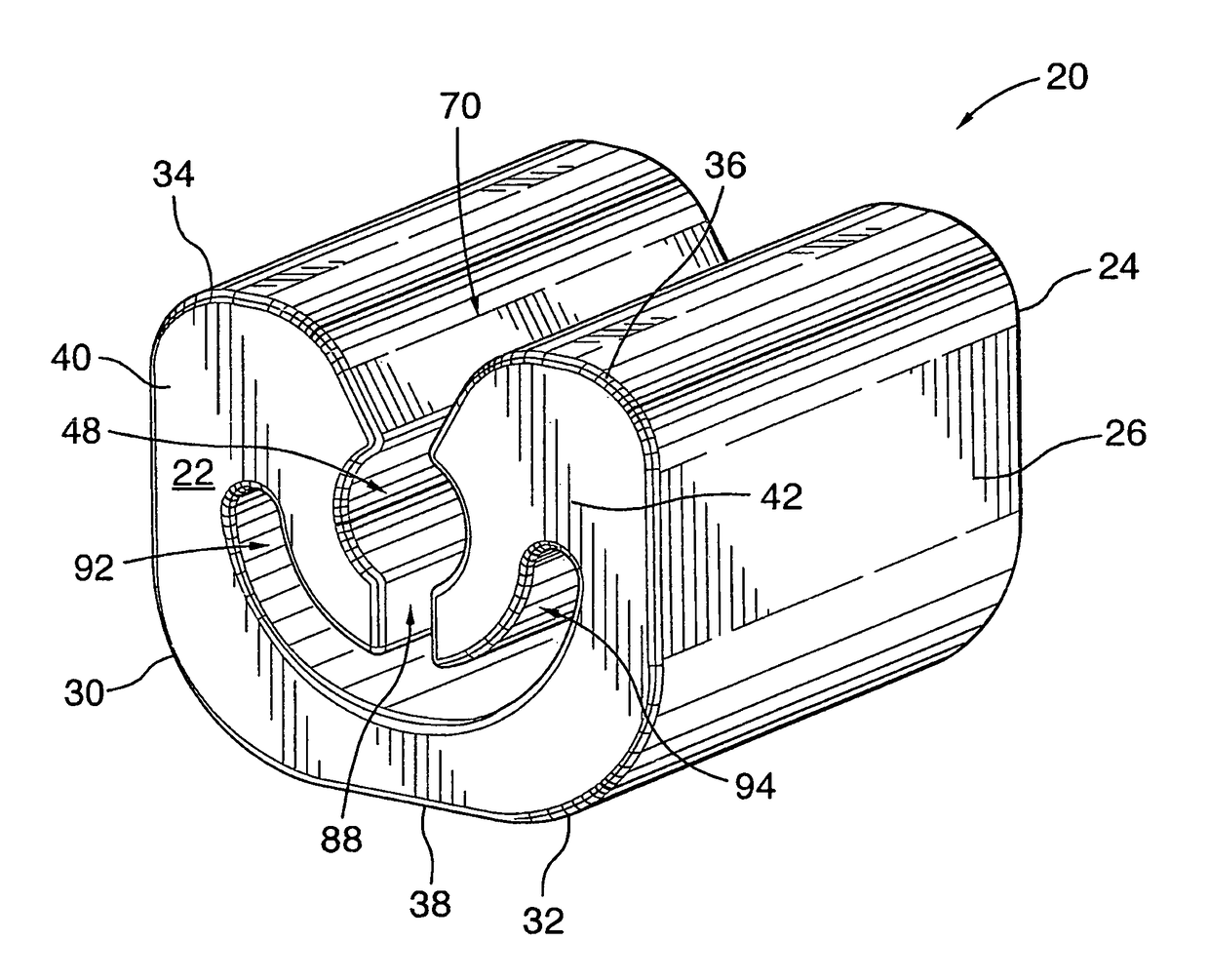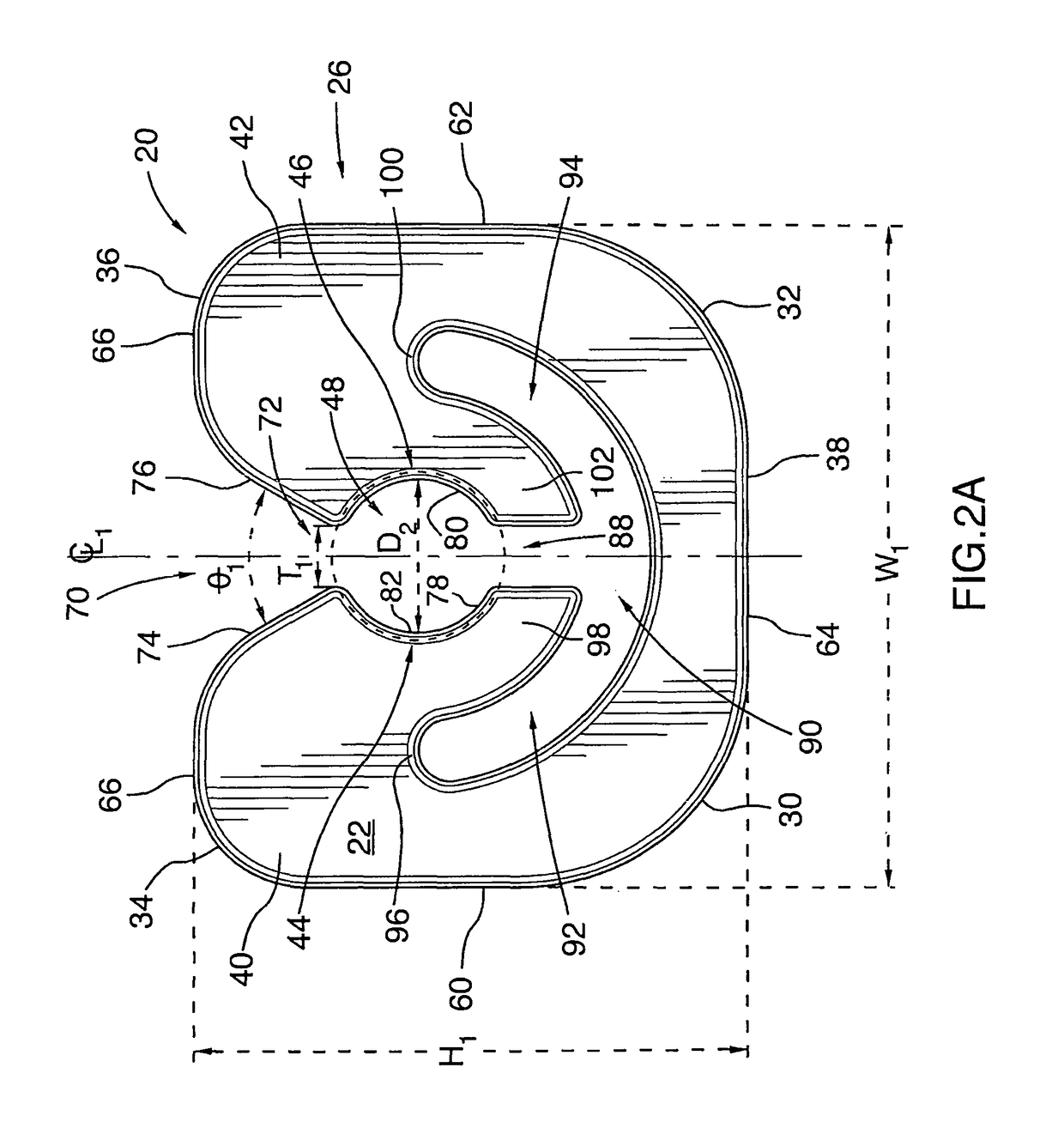Orthodontic gripping device
a technology of orthodontics and gripping devices, which is applied in the field of orthodontics, can solve the problems of difficult field handling and deployment, food to become trapped, irritate the patient's cheeks or gum tissue,
- Summary
- Abstract
- Description
- Claims
- Application Information
AI Technical Summary
Benefits of technology
Problems solved by technology
Method used
Image
Examples
first embodiment
[0070]Referring to FIGS. 1, 2A and 2B, there is shown an orthodontic gripping device in accordance with the present invention designated generally with reference numeral 20. The gripping device 20 is configured for use with an orthodontic arch wire. The orthodontic gripping device 20 includes a mesial face 22, a distal face 24 and an elongate body 26 extending between the mesial and distal faces 22 and 24. In this embodiment, the body 26 is of unitary (one-piece or monolithic) construction fabricated from a superelastic material. Preferably, such material is a superelastic metal alloy. Most preferably, the superelastic metal alloy is nickel titanium, or nickel titanium and other alloying elements (e.g. chromium (Cr), iron (Fe), vanadium (V), aluminium (Al), copper (Cu), cobalt (Co)), such as nickel / titanium / copper or nickel / titanium / copper / chromium. Preferably, the nickel titanium, or nickel titanium and other alloying elements, is cold worked. Although, cold worked and aged nickel ...
second embodiment
[0116]Referring to FIGS. 5A, 5B and 5C, there is shown an orthodontic gripping device constructed in accordance with the principles of the present invention. The gripping device in this embodiment is designated generally with reference numeral 170 and is similar in all material respects (i.e. functionality, configuration and construction) to the gripping device 20 shown in FIGS. 1 to 3, except that gripping device 170 is provided with a hook 172 which depends from the gripping device body 174.
[0117]The body 174 is similar to the body 26 in that it too includes a longitudinal centerline CL1 (shown in FIG. 5B), a transverse centerline CL2 (shown in FIG. 5C), a base portion 176 and a pair of opposed, spaced apart, first and second arm portions 178 and 180 connected to the base portion 176 and disposed on opposite sides of the centerline CL1. The body 174 is symmetrical about the longitudinal centerline CL1 such that the arm portions 178 and 180 are mirror images of each other. The body...
third embodiment
[0124]In the embodiments shown in FIGS. 1 through 5C, the gripping devices 20 and 170 are configured to receive and clamp tightly onto an arch wire of circular cross-section. However, this need not be the case in every application. In a third embodiment illustrated in FIGS. 12 to 17, there is shown an orthodontic gripping device 200 which is configured for use with an arch wire 202 of substantially rectangular cross-section.
[0125]Referring to FIGS. 12, 13A and 13B, the gripping device 200 is generally similar to gripping device 20 described above in that it too has a mesial face 204 and a distal face 206 and an elongate body 208 extending between the mesial and distal faces 204 and 206. In this embodiment, the body 208 is of unitary (one-piece or monolithic) construction fabricated from a superelastic material. Preferably, such material is a superelastic metal alloy. Most preferably, the superelastic metal alloy is nickel titanium, or nickel titanium and other alloying elements (e.g...
PUM
 Login to View More
Login to View More Abstract
Description
Claims
Application Information
 Login to View More
Login to View More - R&D
- Intellectual Property
- Life Sciences
- Materials
- Tech Scout
- Unparalleled Data Quality
- Higher Quality Content
- 60% Fewer Hallucinations
Browse by: Latest US Patents, China's latest patents, Technical Efficacy Thesaurus, Application Domain, Technology Topic, Popular Technical Reports.
© 2025 PatSnap. All rights reserved.Legal|Privacy policy|Modern Slavery Act Transparency Statement|Sitemap|About US| Contact US: help@patsnap.com



